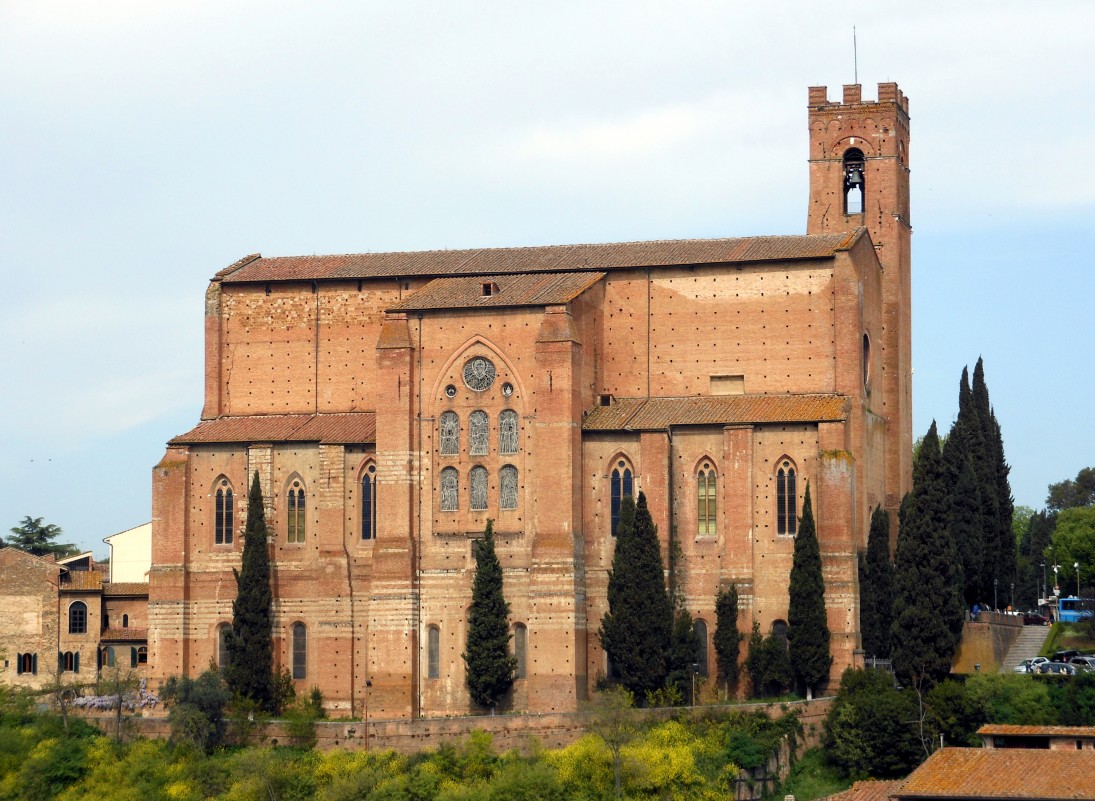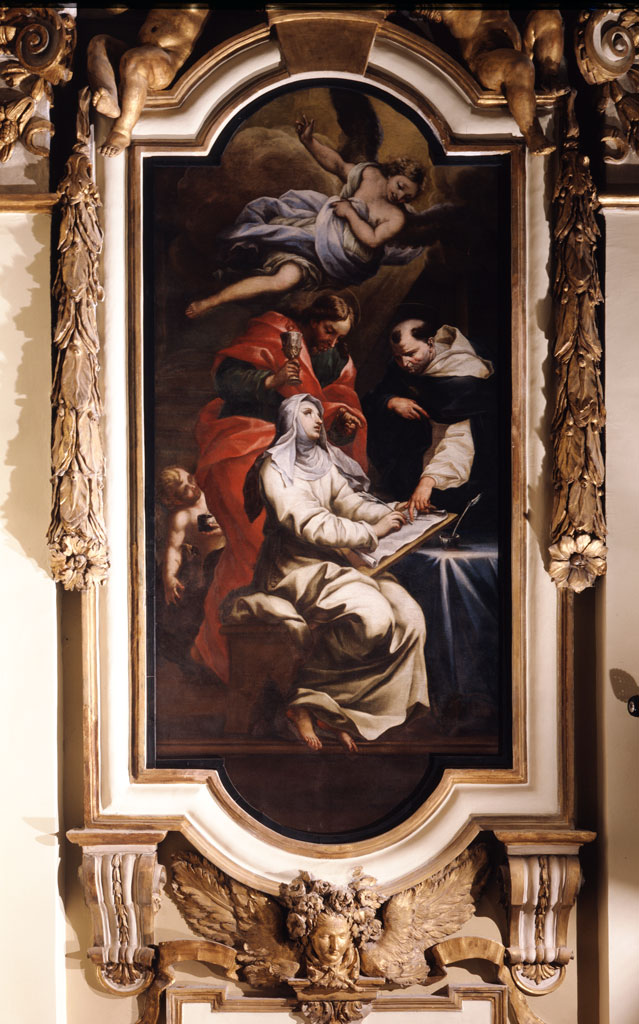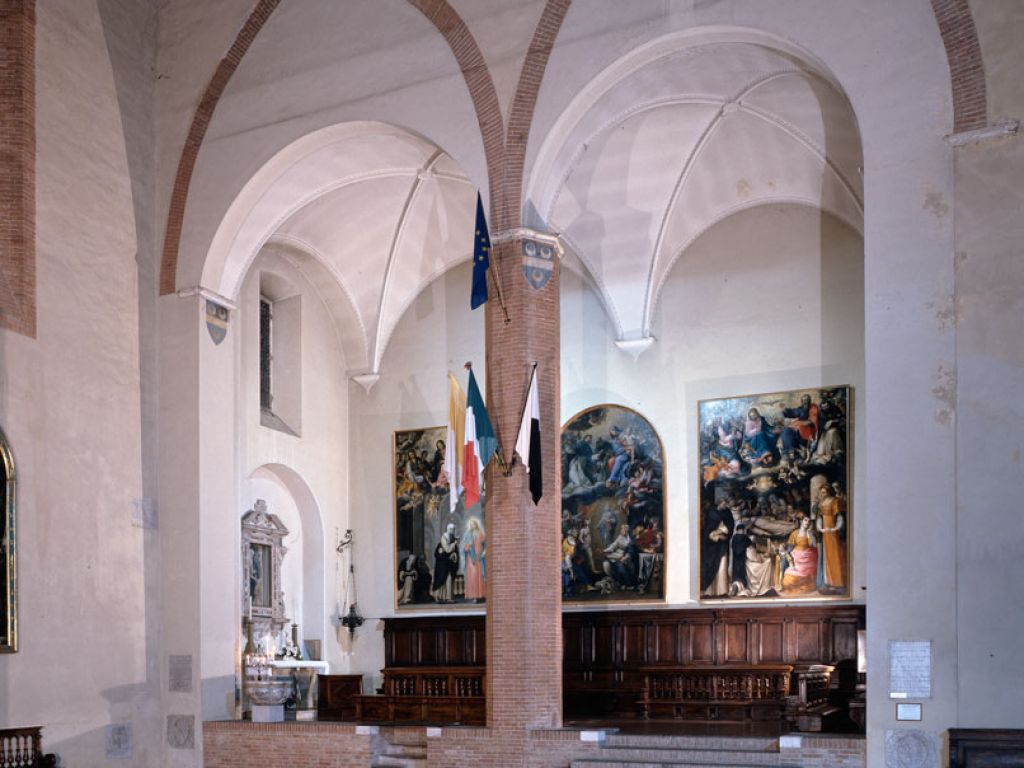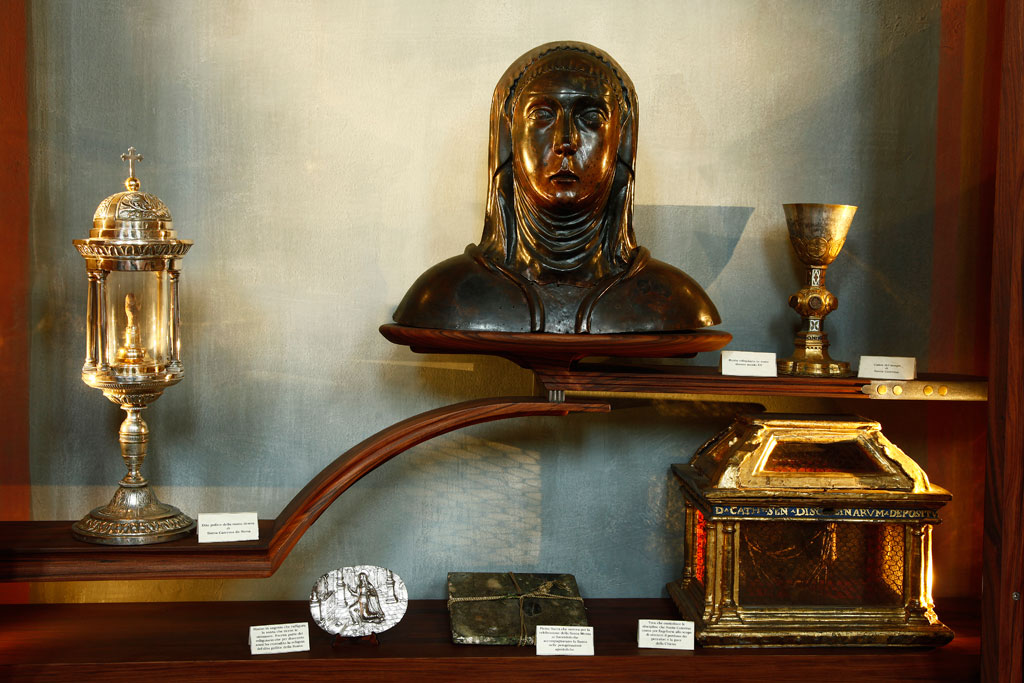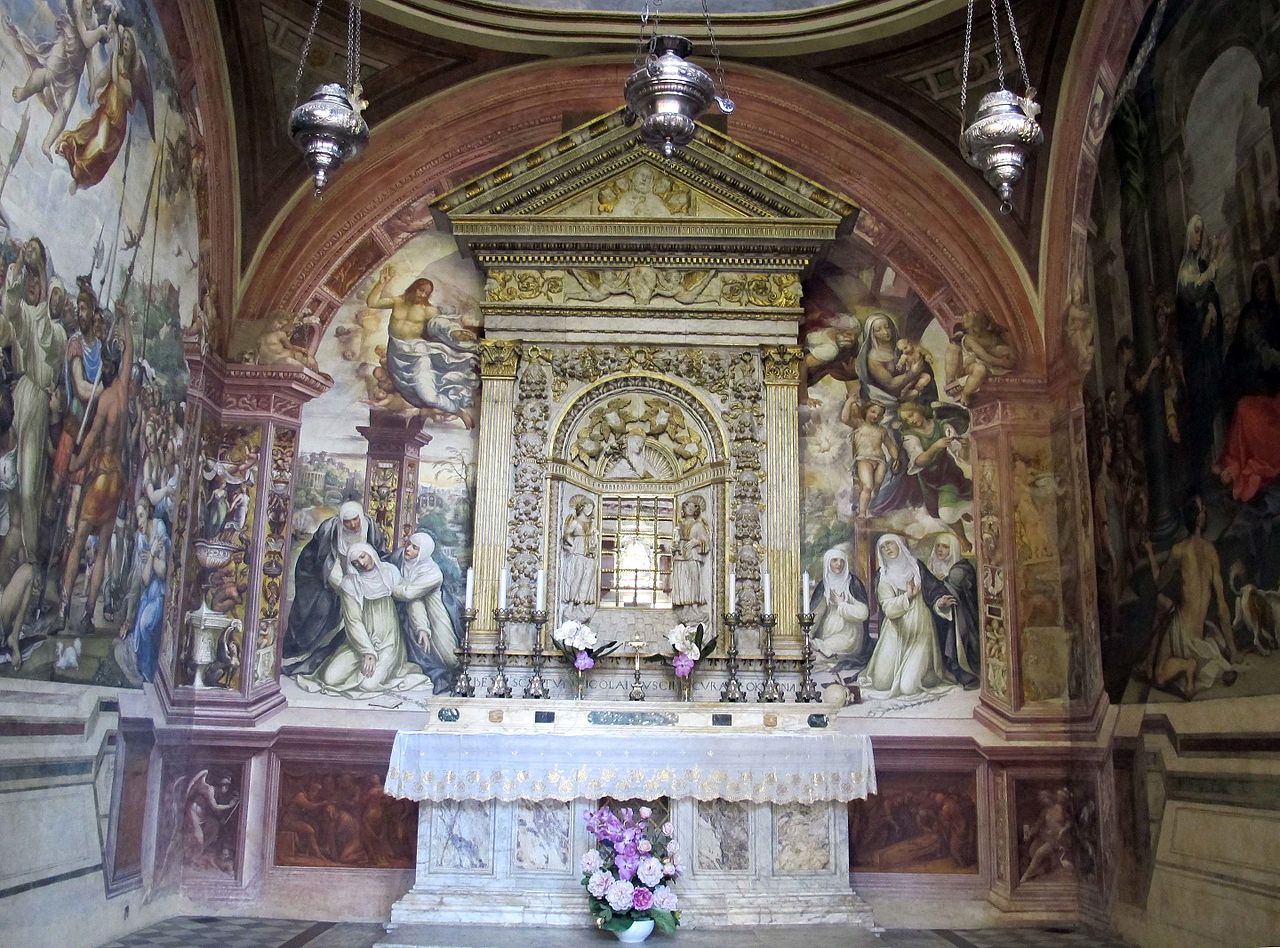BASILICA OF SAN DOMENICO
MAPBASILICA OF SAN DOMENICO
The imposing bulk of the Basilica of San Domenico offers a visual image of the influence of the Dominican friars in Saint Catherine’s Siena. Saint Francis and Saint Dominic had created an original way of living the religious life, well-suited to the new commercial cities. Their friars did not produce by themselves everything they needed, as did the monks, but depended on the generosity of the people in whose midst they lived; they were “mendicants.” The convents were located on the edge of town, on the outskirts where the poorest were relegated; the large size of their churches was conceived precisely so they could house the great masses of common people during religious services. In this church, which dominates the district of Fontebranda where she lived, Saint Catherine attended Holy Mass a great many times.
This place explains also Saint Catherine’s theological learning: the official name of the Dominicans was the Order of Preachers, because their aim was the teaching of the truths of the faith. Therefore Saint Catherine, despite her humble origins, was able to count on a good religious instruction, which she would develop more deeply and so wonderfully with her later divine revelations.
THE DOMINICANS IN SIENA
The order began in the early thirteenth century in Languedoc (France), founded by the Spanish canon Dominic de Guzmán for the purpose of fighting the spread of the Cathar heresy. Dominic and his companions chose to fight the heretical doctrines both by preaching and by the example of severe personal asceticism, living in poverty and begging for their food. Since, in order to refute the heterodox doctrines, it was necessary for the preachers, besides being exemplarily poor, to have also a solid cultural background, Dominican convents became important centers of theological and Biblical studies, and some of the most important medieval theologians, such as Thomas Aquinas and Albert the Great, belonged to the order.
The first friars arrived in Siena with the founder Saint Dominic around 1215-16, when he went to Rome to see Pope Honorius III for approval of the Rule of the Order of Preachers, which was officially decreed on 22 December 1216. At first, the group of friars were given hospitality on the south side of the city; then, in 1225, the Sienese gentleman Fortebraccio Malavolti gave them the Camporegio hill so they could build a church and their convent there.
The settlement of Dominicans in the city of Siena was due mainly to the presence of the Studium (which became the University) and to the fact that the Order had set itself the task of combating heresy and pursuing the salvation of souls by means of preaching and teaching. Precisely because of their teaching charism, Dominicans are present in the main university towns of Europe.
Both the church and the convent were finished around 1262-1265. The church was very big because it had to answer the needs of a new evangelization, and thus had to be able to hold the great crowds of people who came to hear the preaching of the Preaching Friars, or the Dominicans.
With Grand Duke Leopold’s reforms, the convent of San Domenico was suppressed, and in 1786 it became a Cassinese Benedictine monastery, until 1912 when the Benedictines left; thus in 1920 the Dominicans were able to return to their church and convent, where they still reside today and safeguard the memory of the spirituality of Saint Catherine of Siena.
ARCHITECTURE
The basilica of San Domenico is a splendid example of Gothic architecture typical of the Dominican mendicant orders of the thirteenth and fourteenth centuries. Built between 1225 and 1265, in the course of the fourteenth century it was enlarged into the simple, majestic form we still see today.
From the height of the Camporegio hill (tradition claims that King Henry IV camped there during the siege of 1186, hence the name, which means “royal camp”), it dominates the Oratory of the Contrada dell’Oca (formerly the space occupied by the Benincasa dyers), the church of the Crucifix, and Saint Catherine’s House.
In the aesthetic sobriety of its forms and its impressive bulk, ideal for holding the greatest number of faithful, the basilica responds to the Dominicans’ evangelization needs; they built it near the city in order to pursue their work of teaching and spiritual direction in close contact with the community of Siena.
The entire structure is made of bricks, and its exterior is distinguished by its lack of decoration; the only elements breaking up the expanse of wall surface are the long, narrow slits created to flood the church interior with light. Gothic architecture, in fact, sought to have the greatest illumination possible; light, a sign of God, entered and with its brightness chased away the darkness of the human condition.
The entrance to the basilica is on the left side of the church because the area behind the façade, which was begun but never finished, is occupied by the raised structure of the Chapel of the Vaults, an ancient place of prayer for the Dominican Third Order and a sacred place tied to numerous episodes of the sanctity of Catherine of Siena.
The monumentality of the basilica is even more evident inside because of the great height of the large nave, roofed with wooden beams, and above all the vastness of the space that stretches forward until the eye comes to rest on the high altar, the focal point of the church.
The altar is the place where Christ’s Sacrifice, the cornerstone of salvation, is re-enacted. This was the center of interest also for Catherine, deeply in love with her Lord who shed His Blood for her.
On the wall opposite the entrance door is the Saint Catherine Chapel, built by order of Niccolò Bensi in 1460, which houses Saint Catherine’s head, brought here from Rome in 1384 by Raymond of Capua, in the splendid marble altar by Giovanni di Stefano.
THE CHAPEL OF THE VAULTS
The Chapel of the Vaults, also called the Chapel of the Miracles, is the starting point for getting to know the figure of Saint Catherine.
In this space, which is raised higher than the rest of the nave, where the Dominican tertiaries (called Mantellate because they wore a cloak, mantello in Italian) would gather to pray, Catherine lived a large part of her extraordinary mystical experience.
It is in this chapel that she, at a very young age, donned the habit of the Third Order of Saint Dominic, becoming a Mantellata after deciding to consecrate her entire existence to God. It was here, too, that the saint, withdrawn in prayer, was struck by frequent bouts of ecstasy, during which she would lean on the octagonal pillar on the open side of the chapel. Her continuing conversations with Jesus Christ which took place here and were faithfully transcribed by her disciples were the source of the Dialogue on Divine Providence, her most important work of doctrine.
Entering the chapel and turning left, you see the painting of Saint Catherine and a Follower, by Andrea Vanni . This is a fresco that was originally on the adjoining wall, forming a corner with the church; it was detached and moved to its current location in 1667. This painting is exceptionally important because it was made when Catherine was still alive; thus it is rightly considered to be her ‘vera imago,’ a true portrait of her facial features. This is further confirmed by the fact that Andrea Vanni was a faithful disciple of the saint, who wrote to him some of the letters that appear in her Epistolary. With this work, the artist wanted to express all his devotion to the woman he considered “Mother and Teacher.” In the fresco, Catherine appears in the white habit and black cloak of the Mantellate; she hold a lily, the symbol of purity, which over time would become her traditional iconographical attribute. Observing her hands, you will note that they bear the stigmata; this important detail enables us to establish with certainty that the painting was made after 1 April 1375, when Catherine received the stigmata in the church of Santa Cristina in Pisa. The young woman kneeling in an attitude of devotion is a disciple, a symbol of all Catherine’s spiritual children, yesterday as today, and of all those who want to know her life, works, and message of peace.
On the opposite wall are two paintings presenting the main miracles which took place right in this chapel and are reported by Catherine’s biographer and confessor, Raymond of Capua, in the Legenda Major. In one of these, the saint gives her clothes to Jesus, who appears to her in the guise of a pilgrim. The recognition of Jesus in the poor is a common trait of the lives of many saints and the reason for their bursts of charity. In the second picture, Jesus returns to Catherine the cross from the rosary that she herself had given to Him. Both canvases are by the Sienese painter Crescenzio Gambarelli and are dated 1602.
The remaining paintings that can be admired in the chapel retrace other moments in the saint’s life. To the sides of the wall facing the entrance are two paintings by Crescenzio Gambarelli, both dated 1602, depicting Saint Catherine Reciting the Divine Office in Jesus’ Company and The Death of Saint Catherine. In the center is Saint Catherine Appearing to Saint Rose of Lima, the work of the Sienese artist Deifebo Burbarini.
In the center of the right wall is a major painting made by Mattia Preti between 1672 and 1673, when the artist was staying in Malta. The work, commissioned by the Piccolomini family for their altar in the Basilica of San Francesco, was moved to San Domenico in 1890 and placed in the Chapel of the Vaults. The canvas depicts the solemn historic moment when Pope Pius II, Enea Silvio Piccolomini of Siena, blesses his nephew Francesco Piccolomini, archbishop of Siena, after handing him the papal bull of canonization of Saint Catherine, that is to say the official declaration of her sainthood, on 29 June 1461.
THE RELIQUARY NICHE
Along the right side of the nave, in a niche inserted into the wall, are some relics of Saint Catherine.
The term relic (from the Latin reliquus = remained) means what is left of the body of persons who have been recognized as possessing extraordinary virtues of holiness. Over time the term has been extended also to the clothing and objects that came into direct contact with saints.
The veneration of relics emerged as a practice from the earliest times of Christianity and takes its origin from the fact that God became man, leaving concrete traces of His life on earth. This practice was extended later to the relics of saints, considered ‘other Christs’ whose remains were preserved. The golden age for the veneration of relics was the Middle Ages: the presence of relics meant, for the town or shrine that possessed them, prestige and protection, besides making them important pilgrimage sites.
The niche holds Catherine’s thumb, preserved inside a crystal and silver reliquary. For the festivities in honor of the saint which are celebrated every year, the reliquary is carried into Piazza del Campo and used to bless Italy and Europe, of which Catherine is patron saint.
The niche also contains some objects which came into contact with the saint: the chalice with which she received the Eucharist from Jesus, the ropes she used to discipline herself three times a day, and the sacred stone to be placed on the portable altar so that wherever she was, a priest could celebrate Holy Mass and administer the Sacraments to her. It seems that the blood of Thomas Becket spattered this stone when he was murdered in Canterbury Cathedral, where Catherine went on a pilgrimage.
In the center of the niche is the bust made of embossed bronze in which the saint’s head, the most important of her relics, was first kept. Now it is in the nearby chapel.
THE SAINT CATHERINE CHAPEL
The chapel, created by taking over the front part of the old sacristy, was ordered built by Niccolò Bensi in 1466 to hold the sacred head of Saint Catherine, the most important and valuable of her relics, which was brought to Siena after her death.
Catherine died in Rome on 29 April 1380 and was buried in the cemetery of Santa Maria sopra Minerva, but soon afterwards, because the cemetery was so damp, her body was exhumed and buried inside the church itself. On this occasion, Raymond of Capua, at the time General of the Dominican Order, asked and obtained from Pope Urban VI permission to detach the head from the body. The sacred relic was secretly taken to Siena in a silk bag which is still preserved in the Shrine of her house.
In 1385 Raymond informed the Consistory of the Republic of Siena that Catherine’s head was in Siena. Thus a solemn procession was organized, starting from the church of San Lazzaro outside Porta Romana, and moving towards the Basilica of San Domenico, where the relic was placed, enclosed in the copper bust which is now kept in the case to the right of the entrance into the chapel.
After Catherine’s canonization on 29 June 1461 by Pope Pius II, Niccolò Bensi, a member of a Sienese family, decided to have this chapel built to give the precious relic a worthy setting. The beautiful marble altar in the center of the back wall was carved in 1466 by Giovanni di Stefano, also commissioned by Bensi, as the inscription running along the base tells us. The sacred head is inside the central niche, protected by a gold grille. The copper bust which contained it earlier was replaced by one made of silver, designed by Giovanni di Stefano, and then in 1711 by an urn made by Giovanni Piamontini (now kept in a chapel in the right transept), where the relic stayed until 1931, when the Dominicans decided to place it in the current urn made of silver and enamels in the form of a Gothic church by the Florentine goldsmith David Manetti according to a design by the silversmith Angelo Giorgi.
In the course of the centuries, the sacred relic has been involved in various tumultuous events, but has always remained intact. In 1531 it risked destruction by a violent fire that broke out in the basilica, but one of the friars, Guglielmo da Firenze, rushed into the flames and carried the relic out to safety. In May 1609, after a procession, the inhabitants of the Fontebranda district attempted to seize it so as to keep it definitively in their neighborhood; riots broke out for several hours, until the Collegio di Balìa (the highest local authority) intervened and had the sacred head brought back to San Domenico. Almost two centuries later, in 1798, the relic remained surprisingly untouched by an earthquake which damaged the basilica; moved to the Cathedral and placed inside the Piccolomini Library, it was brought back to its proper place on the first Sunday after Easter in 1806.
A few decades after the construction of the chapel and its marble altar, the painted decoration of the walls was begun. In 1526 the artist Giovanni Antonio Bazzi, known as Sodoma, painted to the sides of the altar two of his most celebrated masterworks, The Mystical Trance of Saint Catherine and The Ecstasy of Saint Catherine, which bear witness to the intensity with which Saint Catherine prayed. Her trance was not a matter of ‘sentimental’ excess, but of losing consciousness in the face of the greatness of God’s love. Her ecstasy was a consequence of being completely absorbed by contemplation of God, so much so that it is also called spiritual rapture. Despite the limited wall surface available to him, the artist succeeded in given these scenes an extraordinary monumentality, joining to the perfection of the drawing and the masterful combination of colors a solemn, measured compositional structure. Sodoma also painted the large, crowded fresco of The Beheading of Niccolò di Tuldo. This episode is narrated in one of the most meaningful pages of the Epistolary. In 1377 Niccolò di Tuldo, a gentleman from Perugia, was unjustly sentenced to death by the Sienese magistrates for spying. While he was in prison, he fell into a state of profound desperation. Saint Catherine came to visit him and comforted him with her words to the point that he managed to submit his will to the divine plan, letting himself be led to the scaffold “like a meek lamb.”
The painting on the opposite wall was done in oils on the wall surface by another great Sienese painter, Francesco Vanni, between 1593 and 1596. The scene, set on a columned porch, shows Saint Catherine Freeing a Woman from Possession by a Devil amid the wonderment of a mixed crowd of bystanders made up of noblemen, religious, beggars and ordinary people, underscoring the universal nature of the saint’s message.
The chapel is completed by a very fine fifteenth-century inlaid marble floor illustrating Orpheus and the Animals, designed by an artist whose manner is close to Francesco Giorgio Martini.





